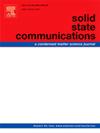Synergistic effect of MoO3 conducting nanofillers on dielectric and electrical properties of P(VDF-HFP)-(Ba0.85La0.15)(Fe0.5Nb0.5)0.9625O3 composite films
IF 2.4
4区 物理与天体物理
Q3 PHYSICS, CONDENSED MATTER
引用次数: 0
Abstract
This study investigates the synergistic impact of MoO3 as a conducting nanofiller on poly(vinylidene fluoride-co-hexafluoropropylene)/La3+ modified barium iron niobate (P(VDF-HFP)-BLFN) composites prepared by the solution casting technique. The dielectric and electrical performance of PVDF-HFP-BLFN-MoO3 composite films with various weight percentages of MoO3 content was studied. The structure and microstructure of the PVDF-HFP-BLFN-MoO3 composite films were analyzed by X-ray diffraction and scanning electron microscopy techniques. The structural analysis verifies the existence of the polymeric electroactive β-phase of the matrix (PVDF-HFP) and the perovskite phase of the integrated ceramics within the matrix. The surface morphology of the synthesized composite exhibits distinct and evenly dispersed particles with little aggregation. A broad frequency range (102–106 kHz) was used to assess the dielectric and electrical characteristics of polymer composite films with varying MoO3 concentrations. The use of MoO3 markedly improved the dielectric constant while preserving a reasonably low dielectric loss, with optimum performance seen at 10 wt% ceramic content. The composites demonstrated frequency-dependent dielectric properties, ascribed to Maxwell-Wagner relaxation at lower frequencies and α-relaxation of PVDF-HFP at elevated frequencies. The increased characteristics arise from the synergistic interaction of the polymer matrix, ceramic particles, and conductive nanofiller, resulting in an improved interfacial polarization effect. These results show the capability of these nanocomposites for advanced energy storage and harvesting applications.
MoO3导电纳米填料对P(VDF-HFP)-(Ba0.85La0.15)(Fe0.5Nb0.5)0.9625O3复合薄膜介电性能和电学性能的协同效应
研究了MoO3作为导电纳米填料对溶液铸造法制备的聚偏氟乙烯-共六氟丙烯/La3+改性铌酸铁钡(P(VDF-HFP)-BLFN)复合材料的协同作用。研究了不同MoO3含量的PVDF-HFP-BLFN-MoO3复合薄膜的介电性能和电性能。采用x射线衍射和扫描电镜技术对PVDF-HFP-BLFN-MoO3复合膜的结构和微观结构进行了分析。结构分析证实了基体中存在聚合物电活性β相(PVDF-HFP)和集成陶瓷的钙钛矿相。合成的复合材料表面形貌表现出颗粒明显、分散均匀、聚集少的特点。使用宽频率范围(102-106 kHz)来评估不同MoO3浓度的聚合物复合膜的介电特性和电学特性。MoO3的使用显著提高了介电常数,同时保持了相当低的介电损耗,当陶瓷含量为10 wt%时,性能最佳。复合材料表现出频率相关的介电性能,归因于低频时的Maxwell-Wagner弛豫和高频时PVDF-HFP的α-弛豫。聚合物基体、陶瓷颗粒和导电纳米填料的协同作用提高了材料的特性,从而改善了界面极化效应。这些结果表明这些纳米复合材料具有先进的能量存储和收集应用的能力。
本文章由计算机程序翻译,如有差异,请以英文原文为准。
求助全文
约1分钟内获得全文
求助全文
来源期刊

Solid State Communications
物理-物理:凝聚态物理
CiteScore
3.40
自引率
4.80%
发文量
287
审稿时长
51 days
期刊介绍:
Solid State Communications is an international medium for the publication of short communications and original research articles on significant developments in condensed matter science, giving scientists immediate access to important, recently completed work. The journal publishes original experimental and theoretical research on the physical and chemical properties of solids and other condensed systems and also on their preparation. The submission of manuscripts reporting research on the basic physics of materials science and devices, as well as of state-of-the-art microstructures and nanostructures, is encouraged.
A coherent quantitative treatment emphasizing new physics is expected rather than a simple accumulation of experimental data. Consistent with these aims, the short communications should be kept concise and short, usually not longer than six printed pages. The number of figures and tables should also be kept to a minimum. Solid State Communications now also welcomes original research articles without length restrictions.
The Fast-Track section of Solid State Communications is the venue for very rapid publication of short communications on significant developments in condensed matter science. The goal is to offer the broad condensed matter community quick and immediate access to publish recently completed papers in research areas that are rapidly evolving and in which there are developments with great potential impact.
 求助内容:
求助内容: 应助结果提醒方式:
应助结果提醒方式:


